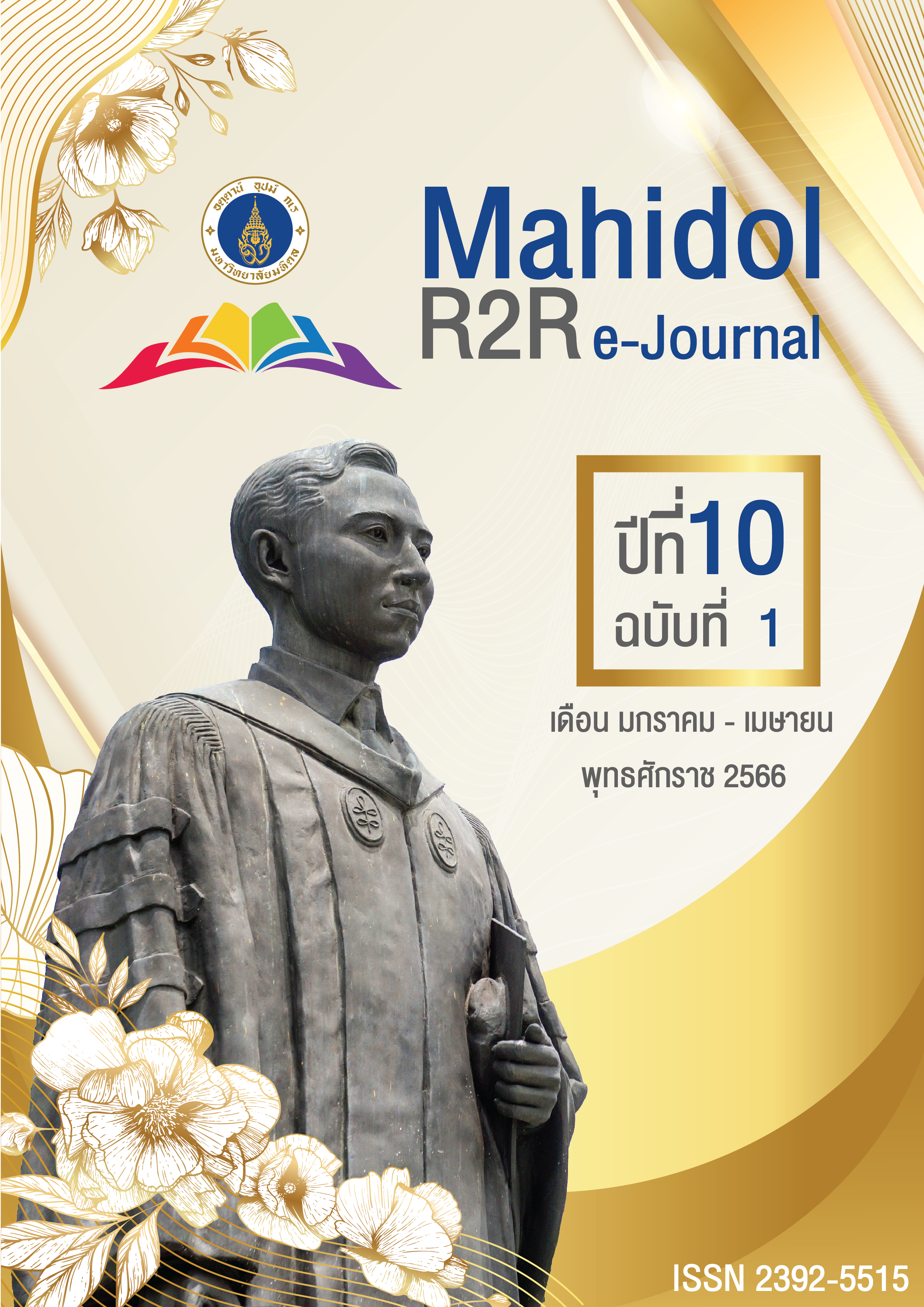Study of In-house Internal QCMs Efficiency for Serum Copper Analysis
DOI:
https://doi.org/10.14456/jmu.2023.5Keywords:
Copper, Homogeneity, in-house Quality Control Material, internal quality control (IQC), StabilityAbstract
The Toxicology Laboratory, Faculty of Medical Technology, Mahidol University had been developed and produced In-house Quality Control Materials (QCMs) of serum copper analysis for replacement. In order to ensure the efficiency of in-house QCMs, the researchers aimed to study the characteristic of this in-house QCMs by following ISO Guide 80:2014. Homogeneity and seven-month study of stability were investigated. The results showed that the concentration of In-house QCMs were 73 and 143 µg/dL (%CV = 2.32, 1.61, respectively) showing relatively low variance and had %recovery 102, 104, respectively. The statistical analysis for homogeneity assessment (F test) showed the value of calculated F less than Fcritical, and p-value > 0.05 (p-value = 0.215, 0.051, respectively) indicating the homogeneity. The linear regression slope of stability assessment showed 95% CI and p-value > 0.05 indicating the stability up to 6 months of both levels.
These results imply that the in-house QCMs had efficiency required according to ISO Guide 80: 2014 statistics and also had appropriate value for using in routine laboratory. Moreover, the process and statistical analysis method in this study could be applied in other In-house QCMs.
References
ถวัลย์ ฤกษ์งาม, อรชุมา ล่อใจ, สุดาวดี คงขํา, และ ดวงเนตร พิพัฒน์สถิตพงศ์. (2561). การศึกษาระดับทองแดง แมกนีเซียม ซีลิเนียม และสังกะสีในผู้สูงอายุชาวไทยที่มีภาวะเมแทบอลิกซินโดรมและระดับน้ำตาลในเลือดสูง. วารสารวิทยาศาสตร์และเทคโนโลยี, 44(2), 5564-5672.
Amos, M. D. (2006). Flame and Vapor Generation Atomic Absorption Spectrometry. In R. A. Meyers (Eds.), Encyclopedia of Analytical Chemistry. John Wiley & Sons. doi: https://doi.org/10.1002/9780470027 318.a5105
Arredondoa, M., & Núñez, M. T. (2005). Iron and copper metabolism. Molecular Aspects of Medicine, 26(4), 313-327.
Association of Official Analytical Chemists International. (2016). Official Methods of Analysis, 20th edition. Appendix F, Guidelines for Standard Method Performance Requirements. United States: The Association.
Atomic Spectroscopy - A Guide to Selecting the Appropriate Technique and System. (2022, September 11) Retrieved from https://resources.perkinelmer.com/lab-solutions/resources/docs/bro_worldleader aaicpmsicpms.pdf
Chuachuada, W., Shiowatanab, J., Chukanchanapitukb, N., Veerasaib, W., Williec, S., & McLarenc, J. W. (2002). Production and Certification of In-house Rice Flour Reference Material. ScienceAsia: Journal of the Science Society of Thailand, 28, 351-358
EFSA Panel on Dietetic Products, Nutrition and Allergies. (2015). Scientific Opinion on Dietary Reference Values for copper. EFSA Journal, 13(10), 4253.
Escott-Stump, S. (2008). Nutrition and Diagnosis-Related Care (6th ed.). Lippincott Williams & Wilkins.
Gonzálvez, A., & de la Guardia, M. (2013). Chapter 3 - Mineral Profile. In M. Guardia & A. Gonzálvez (Eds.), Comprehensive Analytical Chemistry (pp. 51-76). Elsevier.
Hordyjewska, A., Popiołek, Ł., & Kocot, J. (2014). The many "faces" of copper in medicine and treatment. Biometals, 27(4), 611-621.
Houk, R. S., Fassel, V. A., Flesch, G. D., Svec, H. J., Gray, A. L., & Taylor, C. E. (1980). Inductively coupled argon plasma as an ion source for mass spectrometric determination of trace elements. Analytical Chemistry, 52(14), 2283-2289.
International Organization for Standardization. (2014). ISO GUIDE 80 :2014 Guidance for the in-house preparation of quality control materials (QCMs). ISO.
Kodama, H., & Fujisawa, C. (2009). Copper metabolism and inherited coppertransport disorders: molecular mechanisms, screening, and treatment. Metallomics, 1(1), 42-52.
Linder, M. C. (1991). Biochemistry of Copper. Springer.
McArdle, H. J., Andersen, H. S., Jones, H., & Gambling, L. (2008). Copper and Iron Transport Across the Placenta: Regulation and Interactions. Journal of Neuroendocrinology, 20(4), 427-431.
Miller-Ihli, N. J. (1989). In-house biological trace element quality control materials. Science of The Total Environment, 89(3), 361-364.
Moldovan, M. (2019). Atomic Absorption Spectrometry—Flame. In P. Worsfold, C. Poole, A. Townshend, & M. Miró (Eds.), Encyclopedia of Analytical Science (3rd ed., pp. 144-148). Academic Press.
National Research Council. (2000). Copper in Drinking Water. The National Academies Press.
Rowin, J., & Lewis, S. L. (2005). Copper deficiency myeloneuropathy and pancytopenia secondary to overuse of zinc supplementation. Journal of Neurology, Neurosurgery & Psychiatry, 76(5), 750-751.
Sorbo, A., Semeraro, A., Pastorelli, A. A., & Patriarca, M. (2013). Control charts in multi-element analysis of human urine. Accreditation and Quality Assurance, 18(4), 307-312.
Stern, B. R. (2010). Essentiality and Toxicity in Copper Health Risk Assessment: Overview, Update and Regulatory Considerations. Journal of Toxicology and Environmental Health, Part A, 73(2-3), 114-127.
Tapiero, H., Townsend, D. M., & Tew, K. D. (2003). Trace elements in human physiology and pathology. Copper. Biomedicine & pharmacotherapy, 57(9), 386-398.
Walsh, A. (1955). The application of atomic absorption spectra to chemical analysis. Spectrochimica Acta, 7, 108-117.
Wazir, S. M., & Ghobrial, I. (2017). Copper deficiency, a new triad: anemia, leucopenia, and myeloneuropathy. Journal of community hospital internal medicine perspectives, 7(4), 265-268.
Wiwanitkit, V. (2008). Minor heavy metal: A review on occupational and environmental intoxication. Indian journal of occupational and environmental medicine, 12(3), 116-121.
Downloads
Published
Issue
Section
License
Copyright (c) 2023 Mahidol R2R e-Journal

This work is licensed under a Creative Commons Attribution-NonCommercial-NoDerivatives 4.0 International License.
ข้อความลิขสิทธิ์ (Copyright text)
บทความที่ได้รับการตีพิมพ์เป็นลิขสิทธิ์ของวารสาร Mahidol R2R e-Journal กองทรัพยากรบุคคล มหาวิทยาลัยมหิดล อนุญาตให้นำข้อความ เนื้อหา รูปภาพ ไปพิมพ์เผยแพร่ได้ แต่ห้ามนำไปใช้ประโยชน์ในเชิงพาณิชย์ หรือมีเจตนาเอื้อผลประโยชน์ในทางธุรกิจใดๆ
ข้อความที่ปรากฏในบทความแต่ละเรื่องในวารสารวิชาการเล่มนี้เป็นความคิดเห็นส่วนตัวของผู้เขียนแต่ละท่าน ความรับผิดชอบ องค์ประกอบทั้งหมดของบทความแต่ละเรื่องเป็นของผู้เขียนแต่ละท่าน หากมีความผิดพลาดใด ๆ ผู้เขียนแต่ละท่านจะรับผิดชอบบทความของตนเองแต่ผู้เดียว
ผลประโยชน์ทับซ้อน (Conflicts of Interest)
ผู้ประพันธ์ต้องเปิดเผยเป็นลายลักษณ์อักษร (ระบุในรายงาน)ถึงทุกปัจจัยรวมทั้งปัจจัยด้านการเงินที่อาจมีอิทธิผลต่อ การศึกษาผลการศึกษาหรือข้อสรุปจากรายงานการศึกษาวิจัย และจำเป็นต้องระบุหากได้รับการสนับสนุนทางการเงินจาก แหล่งทุนภายนอกเพื่อให้สอดคล้องกับคำประกาศของบรรณาธิการ ผู้ร่วมประพันธ์ทุกท่านต้องมีส่วนร่วมในผลงานการศึกษาวิจัย และควรมีการระบุไว้อย่างชัดเจนในหนังสือปะหน้าประกอบการส่งเรื่องที่จะตีพิมพ์ รวมทั้งระบุไว้ในส่วนของกิตติกรรมประกาศ (acknowledgements) ในตอนท้ายของรายงานต้นฉบับ


